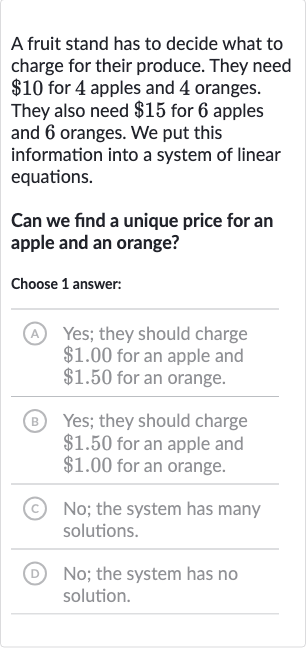AI tutor
Welcome to Bytelearn!
Let’s check out your problem:

A fruit stand has to decide what to charge for their produce. They need for apples and oranges. They also need for apples and oranges. We put this information into a system of linear equations.Can we find a unique price for an apple and an orange?Choose answer:(A) Yes; they should charge for an apple and for an orange.B Yes; they should charge for an apple and for an orange.(C) No; the system has many solutions.(D) ; the system has no solution.
Full solution
Q. A fruit stand has to decide what to charge for their produce. They need for apples and oranges. They also need for apples and oranges. We put this information into a system of linear equations.Can we find a unique price for an apple and an orange?Choose answer:(A) Yes; they should charge for an apple and for an orange.B Yes; they should charge for an apple and for an orange.(C) No; the system has many solutions.(D) ; the system has no solution.
- Define Equations: Let's denote the price of an apple as and the price of an orange as . We can then write the given information as a system of linear equations:. .
- Simplify Equations: We can simplify both equations by dividing them by their common factors to make the coefficients smaller and the system easier to work with:. Divide the first equation by :. Divide the second equation by :
- Identify Identical Equations: We notice that after simplification, both equations are identical, which means they represent the same line. Therefore, there are infinitely many solutions to this system, as any point on the line is a solution.
- Infinite Solutions: Since there are infinitely many solutions, we cannot find a unique price for an apple and an orange. The correct answer is No; the system has many solutions.
More problems from Solve a system of equations using any method: word problems
QuestionGet tutor help
QuestionGet tutor help
